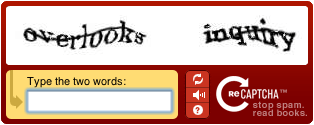"Are you a robot?"
That's the question that reCaptcha forms are designed to answer. You're so used to seeing them on signup pages, you've probably never considered where they came from. And you've almost definitely never realized that you're actively helping transcribe old books and newspapers when you use them.

ReCaptcha forms were created by Dr. Luis von Ahn in 2000. The technology is so good at preventing bots from signing up for services and apps that it spread like wildfire. Within just a few years, most websites used these forms to authenticate new users.
As you well know, these forms are a pain and von Ahn knew it. His math proved what he already knew: his forms were wasting a lot of time.
Dr. von Ahn’s group estimated that humans around the world decode at least 200 million Captchas per day, at 10 seconds per Captcha. This works out to about 500,000 hours per day — a lot of applied brainpower being spent on what Dr. von Ahn regards as a fundamentally mindless exercise.
In search of a better way use all that brainpower, von Ahn teamed up with Google and the New York Times. Instead of presenting users with random words, he presented words taken from photos of old books and newspapers. Soon, 200 million words were being transcribed every day with 99% accuracy.
ReCaptcha had a new revenue stream and the world now has searchable access to previously untranscribed books and information.
Opportunities to improve the world are all around us if we think outside the box.
Have a great day!
Jimmy
Swipe File is a short newsletter that delivers a small dose of inspiration each morning.
